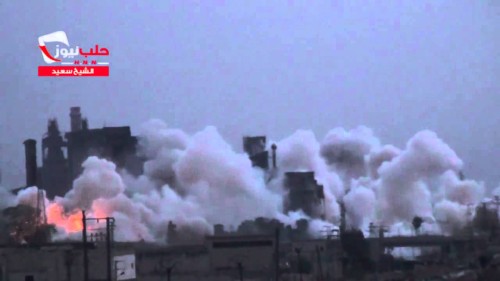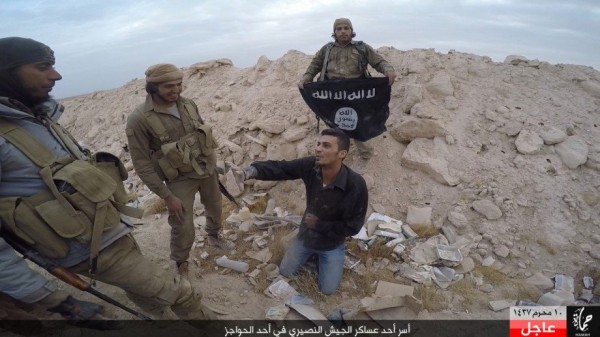PHOTO: Rebel bombardment of a cement factory, near the ring road south of Aleppo
LATEST
- Up to 200 Cases of Food Poisoning from Expired UN Biscuits in Zabadani and Madaya
- Amid Claims of Civilian Deaths, Russia Stops Giving Details of Airstrikes
UPDATE 1630 GMT: Claims are circulating that the Islamic State has advanced farther against the Syrian military, taking the village of Sheikh Halal, east of Hama city (see map).
ORIGINAL ENTRY: In another shift on the battlefield, both rebels and the Islamic State have put pressure on the Assad regime near Aleppo, threatening to cut the Syrian military’s only route into Syria’s largest city.
Rebels occupied part of the ring road south of the city, as they seized a cement factory in Sheikh Sa’eed on Sunday (see map). Fighting for the factory through the day.
Rebel occupation would cut the regime’s main route from Aleppo International Airport to the city, as well as break the link between Aleppo and Hama. Amid the threat, the Syrian military may already be using back roads, for example, near al-Sherfee (see map).
Footage of rebel bombardment of the factory:
Rebels in Sheikh Sa’eed:
Meanwhile, the Islamic State continued to hold a section of the Khanasir-to-Aleppo road to the east of the city, having taken it over the weekend. The militants reportedly occupy at least 15 km (10 miles) of the 50-km (31 mile) route.
One of a series of photographs posted by ISIS, celebrating the victory at the road (see map):
The Syrian military launched an offensive last week to the south and east of Aleppo, hoping to surround the city which has been divided since July 2012. The regime also hoped to lift the Islamic State’s siege on Kweires airbase, which has been cut off since late 2012.
The Aleppo front was the sixth in the regime-Russian offensive which began on October 7, with ground assaults covered by intense Russian bombing and supported by Hezbollah and Iranian-led units.
Pro-regime activists continue to insist that the Syrian military has the upper hand in the battles, claiming the capture of a total of about 90 square km (about 35 square miles) — more than 45 square km from rebels and more than 40 from the Islamic State.
The English-language site of Iran’s Fars News, which now focuses almost exclusively on the Syrian conflict, proclaims:
The Syrian Army announced on Sunday that its forces have killed over 130 militants alongside Khanasser- Ithriyah road in the Southern parts of the Northern city of Aleppo in the last 24 hours.
The sources said that the terrorists were killed in the Army’s cleansing operation [from the Islamic State] of the Khanasser-Ithriyah road.
Up to 200 Cases of Food Poisoning from Expired UN Biscuits in Zabadani and Madaya
The director of the only field clinic in Zabadani, the opposition-held town in Damascus Province that withstood a 84-day siege this summer, says up to 200 residents in the town and nearby Madya have suffered food poisoning for a UN aid delivery that contained out-of-date high-energy biscuits.
The UN Resident and Humanitarian Coordinator in Syria, Yacoub El Hillo, acknowledged that 320 of 650 crates of aid this weekend had the biscuits beccause “of an unfortunate human error during the loading process”.
Abu Nidal al-Suri told Syria Direct that the majority of cases were children:
After the biscuits were consumed, cases of diarrhea and vomiting started to appear and after these cases multiplied, it caught the attention of the medical team. We discovered that [the biscuits] were expired. The rest of them were thrown out….
The residents of Zabadani and Madaya have been blockaded for 120 consecutive days now, so their immune systems are extremely weak. After eating the bad biscuits, they were affected immediately, resulting in cases of poisoning, vomiting, and intestinal swelling.
The UN aid is part of the arrangements of a six-month ceasefire covering Zabadani and the besieged rebel enclaves of al-Fu’ah and Kafraya in Idlib Province in northwest Syria.
Despite the UN’s explanation, al-Suri said he believed the inclusion of the expired biscuits was intentional, filling out the shipment because of a shortage of food: “The residents are resentful and displeased and think the UN and the Red Crescent are conspiring against them by sending them expired food stuffs that poisoned their children, considering no spoiled food was sent to Kafariya and al-Fu’ah.”
Amid Claims of Civilian Deaths, Russia Stops Giving Details of Airstrikes
Russia has stopped giving details of its bombing campaign, amid claims of hundreds of civilian deaths and exposure of Moscow’s deception that all its attacks are on areas controlled by the Islamic State.
Since the start of the airstrikes on September 30, the Defense Ministry had given daily updates on the number and supposed location of attacks. However, in its last briefing on Saturday, spokesman General Igor Konashenkov, merely said that “several districts” had been struck.
Konashenkov told State broadcaster RT on Sunday, “The planes hit targets which have been confirmed to be the terrorist objects using several intelligence sources.”
The exact number of civilians killed in the attacks is unknown, but estimates are circulating of more than 450 since September 30. In the town of Talbiseh in northern Homs Province, more than 100 people, including scores of children, have died in a series of bombings.
Contrary to Russia’s line that the Islamic State is its sole target — revised at times to the general label “terrorists” — about 80% of airstrikes have been on rebel-controlled areas.


